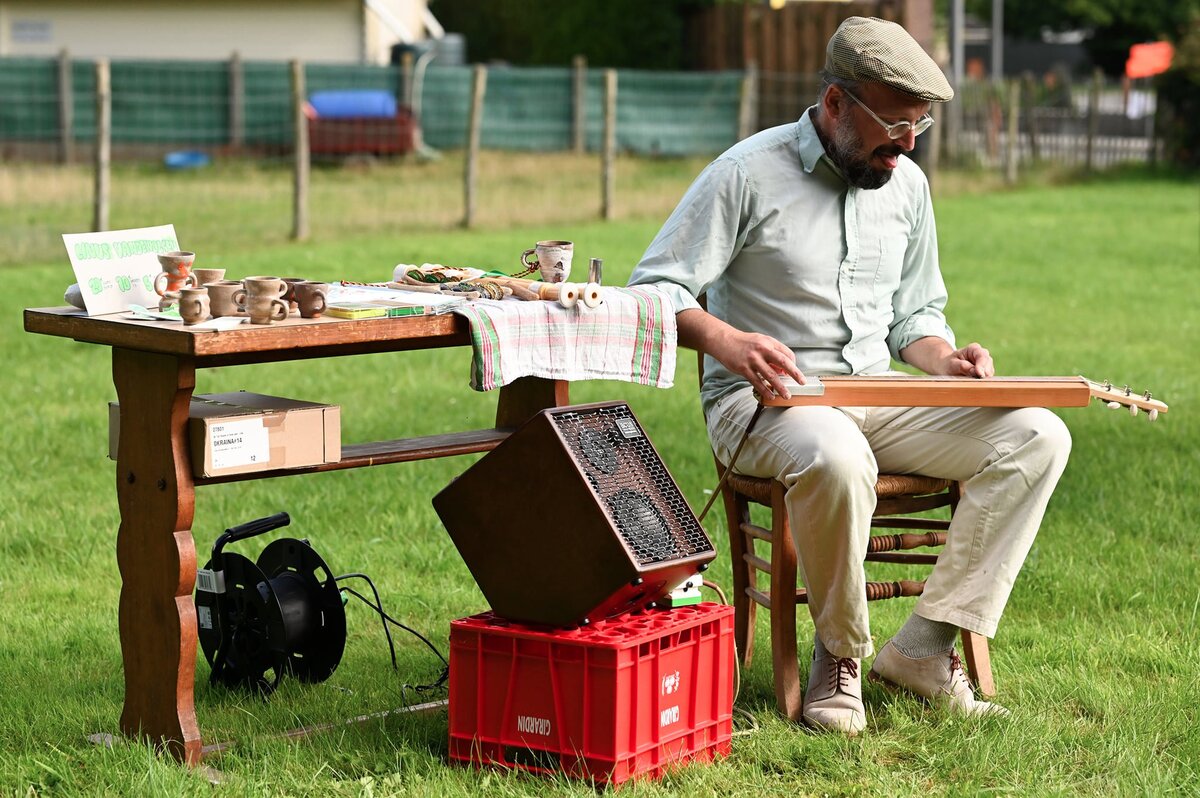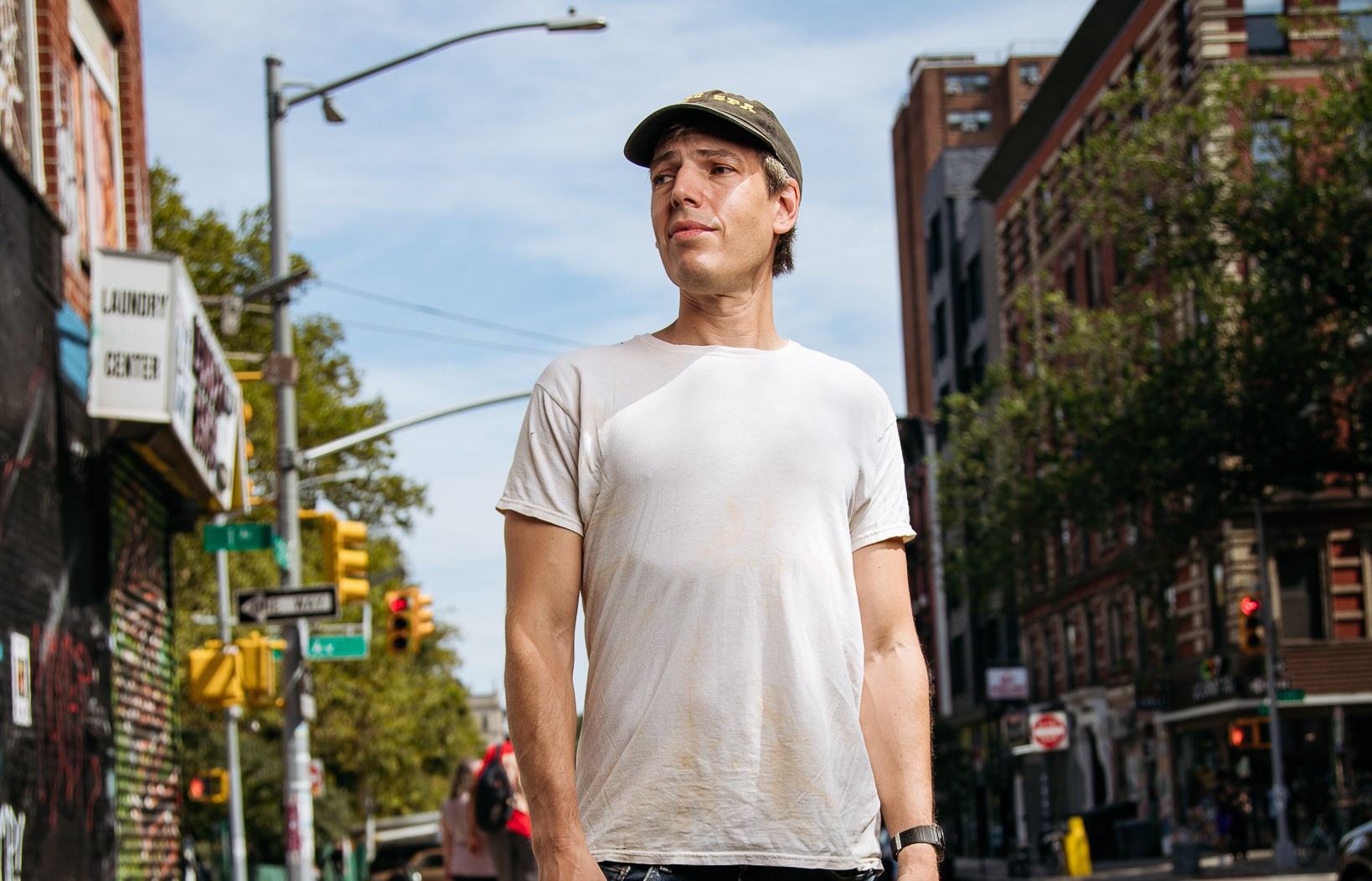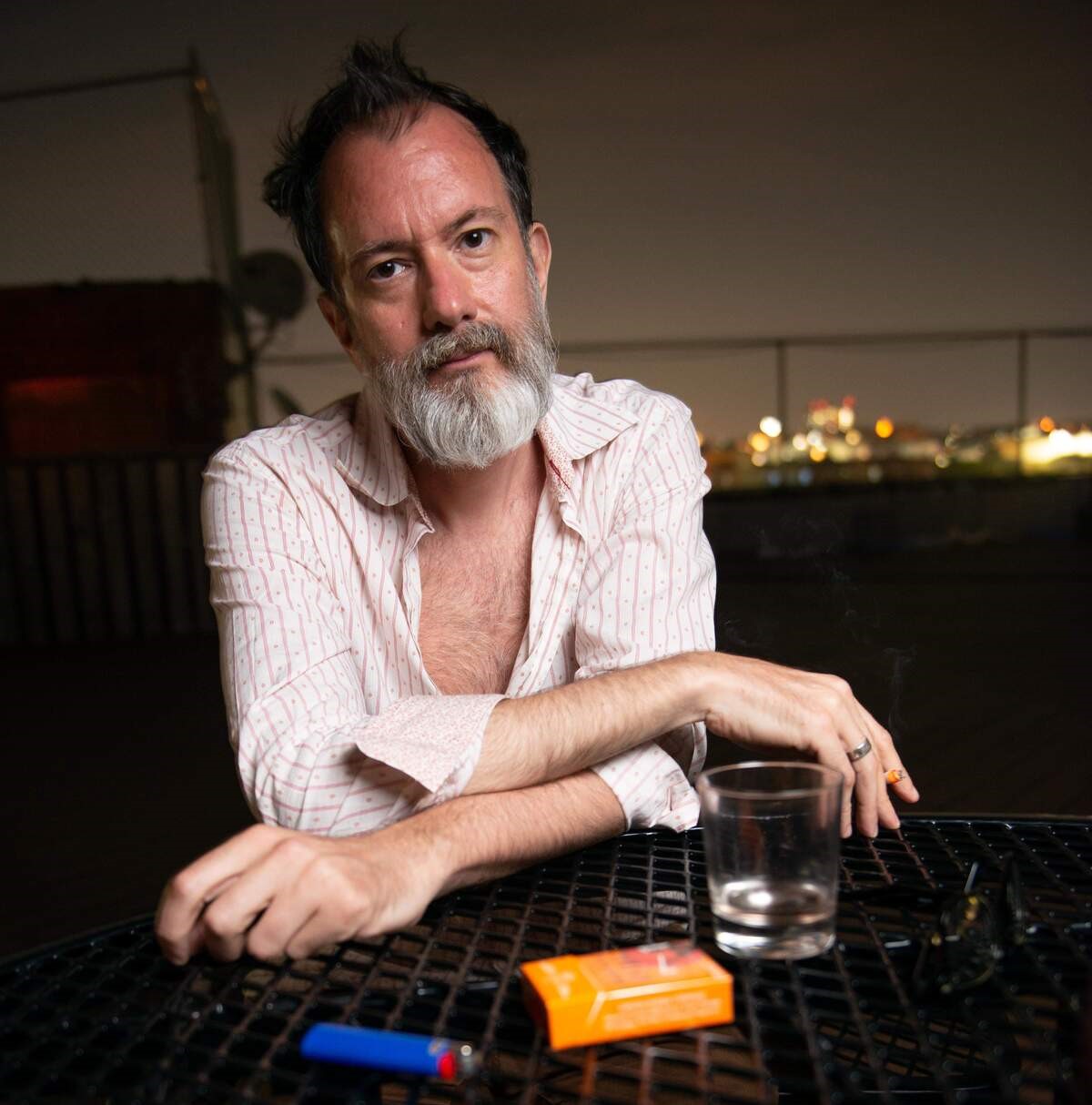Linus Vandewolken | Interview | New Album, ‘Oude Geuze uit Niemandaal’
In ‘Oude Geuze uit Niemandaal,’ Linus Vandewolken (real name: McCloud Zicmuse), an American residing in Brussels, showcases his mastery of the hommel (a Flemish variant of the Appalachian dulcimer), the aulos, and homemade percussion instruments. The album is released by Morc.
As an American living in Belgium, McCloud Zicmuse cultivated a profound appreciation for several customs of his adopted homeland: a particular form of archery (“staande wip”), the festive spirit of carnaval, the art of aging geuze beers, and notably, playing the “hommel,” the Flemish counterpart to the Appalachian Dulcimer. Under the guise of Linus Vandewolken, Zicmuse delved deeply into these traditions, infusing them with his own unique perspective. While his passion for the dulcimer remains authentic, he ventures beyond its conventional confines, incorporating homemade flutes, percussion instruments, and even humming to enrich the musical experience.
“I view an instrument that is both puzzling and intriguing”
Why did you choose the moniker Linus Vandewolken?
McCloud Zicmuse: I use the name Linus Vandewolken for this project because, quite simply, the hommel has a diatonic playable scale, which makes it difficult for me to compose as I usually do. It’s the instrument that guides me through the sonic and melodic possibilities it offers. Since I wasn’t fortunate enough to be born in Belgium, I decided that Linus would serve as an alter ego. “Vandewolken” is a rough translation of “McCloud,” and for me, one of the roots of Linus is “Lin” from the linseed plant (flax) that I see growing in the fields as I ride my bike around the countryside. I chose this name also because the hommel is inherently Flemish, and it made sense to me that Linus would be familiar with this instrument. I could also say that this project is part of my integration process.
When did you move from the US to Brussels?
I ended up in Europe by accident—I missed my plane to the States in 2006. Stranded in France, I stayed there for two years, learned French, and during that time formed a group that went on tour. We eventually played in Brussels. I was only there for three days, but I fell in love with the city. It’s such a peculiar place, brimming with quirks and possibilities, offering just enough space for me to feel at home. After 16 years of living here, I still consider myself an outsider, which is a double-edged sword. I don’t fully integrate into existing circles or cliques, but I believe it grants me a unique perspective to explore and perhaps find fascination in what people born and raised in Belgium might find mundane. Take the hommel, for example—it’s a fascinating and versatile instrument if you allow yourself to be inspired by its possibilities.
Where does your interest in the hommel, the main instrument you play on this album, come from?
There appear to be two general perspectives on the hommel: either people are unaware of its existence, or if they do know about it, they’ve pigeonholed its repertoire into a “traditional music” box. Most of my interactions with the established Flemish folk scene haven’t been very positive, perhaps even condescending. Initially, I attempted to reach out to various associations and players to establish a common interest support group for the instrument. However, most responses I received were along the lines of “you have a hommel, good, I can teach you how to play it,” insinuating that I don’t know how to play the instrument. Even more disheartening was my encounter with one of my heroes, Hubert Boone, who authored an impressive encyclopedic work titled “de Hommel in de Lage Landen” in the early seventies. Of course, attitudes change, and Mr. Boone’s more recent publication is titled “de Hommel, instrument voor de huiskamer,” somewhat relegating the hommel to something that should remain in the home environment. In any case, it was an interesting day when some rooms in the local museum of Kampenhout were opened, dedicated to objects, instruments, and books donated by Mr. Boone. I didn’t expect much, and it was a chance encounter, so I was a little excited at the time. However, I was sorely disappointed by the lack of interest and I might even go so far as to say “rejection.” But in hindsight, the encounter wasn’t so surprising, given the attitudes I had already encountered.
On the other hand, fortunately, there are people who have been positive and encouraging. Upon seeing the liner notes of the disc ‘RUM II,’ I reached out to Pol Rans from the group RUM, and we had a great correspondence. I was even fortunate enough to see a version of the group perform in Haren. Additionally, there is a new comprehensive website run by Jean-François Mazet here. We’ve had some really positive exchanges about the instrument, and you can even find the vinyl releases of Linus Vandewolken in the “Releases” section of the site. So, slowly, there is some opening and exchange happening! And thankfully, the “underground” and “experimental” scenes have been quite openly supportive. Vandewolken has performed at a few events organized by Kraak, Pleasure Island, Divagation, and I must mention the support of Okraïna, who released the double 10-inch vinyl ‘Het Vlier, een Hommel Op Aarde,’ and Morc with the new 12-inch LP ‘Oude Gueze uit Niemandaal.’
Do you think that, as an American living in Belgium, you will always maintain some kind of “outsider position”?
Yes, as an outsider, I view an instrument that is both puzzling and intriguing, mainly found in museums and rarely played. When I visited my father, who is a hobbyist luthier, there wasn’t time to build a guitar, so we constructed a hommel in three days. I’ve been playing it for 10 years now. Having been around my father’s workshop for over 30 years, I began crafting instruments myself after my guitar was stolen from a train in 2007. The integration of self-made instruments into my practice occurred naturally. As a multi-instrumentalist who plays by ear without classical training, I appreciate the unique possibilities each instrument offers: recorder, bassoon, saxophone, clarinet, guitar, bass, keyboards, percussion, and more. So, yes, I am what you would call a “musician.” My passion for sounds drives me to research and delve deeper into exploring instruments and compositional practices. My other project involves a very extroverted big band of up to 14 people. However, I must mention that music is just one facet of how I express myself as an artist; it is intertwined with pottery, letterpress printing, performance, drawing, writing, and various other activities.
With the album: why did you choose Dutch titles?
I opted for Flemish titles because they capture the emotions evoked by the music for me. It’s an intuitive choice. I find the widespread use of English in the music scene and the world at large rather dull. So, I believe it’s fitting that Linus Vandewolken, who resides in Niemandaal, selects titles inspired by the paintings of Bruegel and presents them in Dutch. To me, there’s a beauty and simplicity in Flemish that resonates with the hommel’s own elegance and simplicity. While at home we speak French and English, I’m currently learning Dutch. I read the newspaper and other information sources in Dutch, and my phone is set to Dutch, so incorporating the language into my art serves as a way for me to learn. As an immigrant, I’m grateful for the opportunities and life that Belgium has afforded me, from sports opportunities with my pole archery guild (Koninklijke Gilde Sint Sebastiaan van Schaarbeek) to folkloric engagements in my community, such as being elected Prins Carnaval of Schaerbeek in 2020 (I continue to hold the title due to cancellations and typical surreal situations).
Are you familiar with the music of Lukas De Clerck and his work with the aulos?
Lukas De Clerck saw me playing my homemade aulos-like tubes and double flutes, so he reached out to me, and we’ve developed a friendship and exchange regarding that instrument. I deeply admire Lukas’s work and his dedication to research and inspiration. He asked me to create a clay aulos, though I usually only make cups, thus the Auloskopje was born. It’s still a work in progress, but for now, there are three functional sets of cups. I build the instruments, and Lukas crafts the reeds. Although nothing has been recorded yet, as the newest series has just emerged from the kiln, Linus Vandewolken performed publicly with the Auloskopjes on May 25, 2024, in Ghent. I’m eager to see what Lukas discovers with this intriguing new creation, and I have much exploration ahead of me as well. This story is to be continued.
Joeri Bruyninckx
Headline photo: Marjon Udo
Morc Official Website / Facebook / Instagram / Twitter / Bandcamp




